A decorative reservoir, even a small one, unusually decorates the garden landscape. Mini-ponds are made from a variety of materials, up to a steel bath or a barrel. However, the most popular solution is an artificial pond on a plastic site.
Choosing a finished plastic bowl
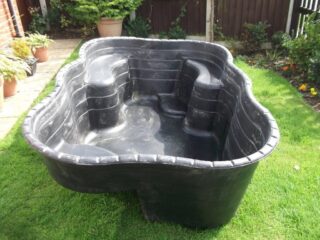
The reservoir for the reservoir is a ready-made structure that can be installed in a recess in the ground. With small dimensions, even a supply pipe is not installed, but only a drain into the sewer or drainage.
Bowls are made from different materials.
- Polyethylene - holds water, does not contribute to the reproduction of blue-green algae. The surface is smooth, so cleaning the pool is easy. They produce containers up to 900 liters. This option is large, but rather fragile, therefore, precautions must be followed during installation.
- Polypropylene - attracts with durability - up to 20 years. The material is flexible, strong, resilient, therefore it is equally well resistant to both shock and constant water pressure. The polypropylene bowl does not leak at all, so there is no need to make additional waterproofing when arranging a pond.
- Fiberglass - durable, resistant to mechanical damage, lasts at least 20-30 years. Fiberglass is not afraid of ultraviolet radiation, temperature changes. Pools of large capacity are produced, since the mechanical strength of the material allows it.
The fiberglass bowl can be repaired if damaged with special compounds. The rest of the plastic ponds at the summer cottage are deprived of such an advantage.
Other factors
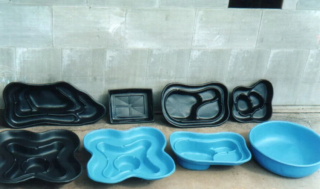
The dimensions depend to some extent on the characteristics of the material. The capacity of a polyethylene bowl rarely exceeds even 600 liters, although theoretically it can reach 900 liters. Pools with a capacity of up to 1200 liters are made of polypropylene, and fiberglass makes it possible to make a pond with a volume of 4000 liters.
It is better to entrust the installation of a large bowl to specialists. Here you will need additional calculations and special equipment.
The shapes of the plastic bowl are varied. The product is cast, not assembled, therefore, the outlines of the sides and the bottom are given any configuration. The shape is chosen based on the characteristics of the landscape and size. It is better to make a mini-pond round or oval. For larger sizes, an elongated, complex configuration would be a better idea.
The color of the plastic bowl is black or blue.
How to choose a place for a reservoir
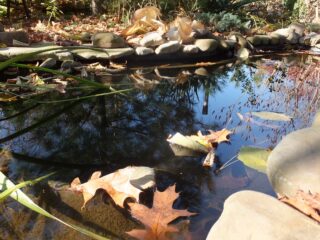
You need to put a pond in the country from a plastic mold in a suitable place:
- the distance from the pond to the outbuildings should be within the framework of SNiP - from 4 to 12 m;
- place the reservoir on a flat area, and not on a slope, otherwise the water presses unevenly on the bottom of the mold;
- the reservoir plays the role of decoration, so it makes no sense to place it in secluded places;
- It is not recommended to place the pool under trees or shrubs, as fallen leaves, flowers and other debris quickly contaminate it;
- the dimensions of the reservoir must correspond to the dimensions of the site.
The pond is an element of the recreation area. Therefore, convenient paths are laid to it, a platform with benches, a bridge is equipped, and the banks are decorated.
Installation of a plastic pond
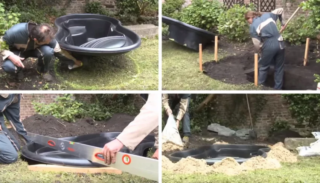
The step-by-step installation of a plastic or fiberglass pond in the country is quite simple. The most difficult part - the pool bowl - comes into the hands of the owner ready-made, and the rest is easy to do.
- Choose a site, level it if necessary, mark out the contours with sand. The dimensions of the future pit should be 15–20 cm larger along the perimeter than the dimensions of the bowl.
- Dig a trench. The top fertile soil is removed and preserved.
- Layers of sand and crushed stone, 20 cm thick, are laid on the bottom and tamped.
- If the pool is large, the bottom is concreted. Grabs a screed 7 cm thick.
- The plastic container is lowered into the trench, giving it the correct position using wooden supports.
- The cavity between the walls of the pool and the pit is covered with sand, moistened so that the sand is compacted, and then the supports are removed.
With a small pond, water is poured into it from a hose, and manually selected with a bucket.
Artificial pond decoration
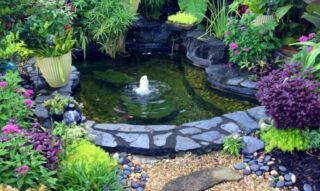
The following design techniques are used:
- the edges of the form are laid out with stones or covered with wooden boards;
- flat pebbles and cobblestones are placed on the bottom of the pools to give it a natural look;
- undersized shrubs and flowering plants are planted around the reservoir;
- a fountain or an artificial stream can be installed in the pond.
Often in the garden, the pond is decorated with lamps.
Maintenance and operation rules
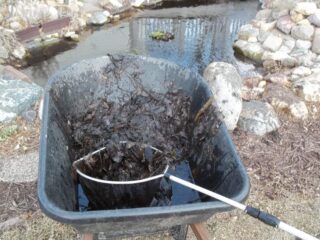
Recommendations for caring for a plastic pond bowl in the country are very simple.
- If in winter the temperature does not drop to -30 below zero, the water from the container need not be drained. If the frosts are stronger, the pool is released for the winter.
- From time to time, the bowl needs to be cleaned of dirt and silt. It is best to use a water vacuum cleaner.
- Leaves, flowers, branches, and other debris are removed with a net.
- If ornamental plants are planted in the pond, they are looked after according to the instructions.
The frequency of cleaning and changing the water depends on the size of the pool and its “population”.
Advantages and disadvantages of a HDPE garden pond
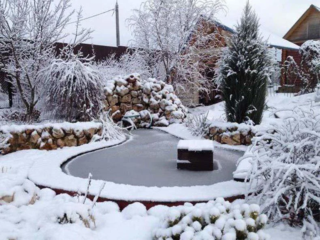
A cheap option is a low pressure polyethylene bowl. Advantages:
- frost resistance;
- inertness - the water in the container does not bloom and does not rot;
- low price;
- ease of installation.
The disadvantages are significant:
- service life less than 10 years;
- weak mechanical resistance;
- burn out and cracks under the influence of direct sunlight;
- the maximum depth of the bowl is not large, so fish should not be left in the pond for the winter.
An artificial reservoir from a ready-made plastic form is a profitable option. If the owner's goal is not to breed fish, HDPE or polypropylene bowls meet all the requirements for ornamental ponds: easy to install, practical, cheap, versatile in shape.








